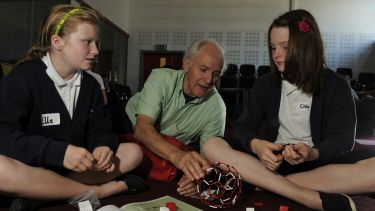About Sir Harry Kroto
Nobel Prize winner Sir Harry Kroto is one of our most famous graduates. Throughout his life, he remained a good friend of the University, and continued to inspire young people when he visited Sheffield for our annual Kroto Day celebrations with local schoolchildren.

Professor Sir Harry Kroto arrived at the University of Sheffield as an undergraduate student to study chemistry in 1958. He graduated with a first class BSc honours degree followed in 1964 by a PhD.
Harry went on to become a leading chemistry researcher and, in 1996, was awarded the Nobel Prize in Chemistry for his discovery of a new form of carbon, buckminsterfullerene.
Buckminsterfullerene
Buckminsterfullerene stands alongside the two other well-known forms of carbon - diamond and graphite. The extraordinary molecule consists of 60 carbon atoms arranged in a sphere, the hexagon and pentagon pattern exactly matching the design of most footballs.
The configuration reminded Kroto of the geodesic domes designed by the architect Buckminster Fuller, hence the name "buckminsterfullerene", or "buckyballs".
Harry was passionate about sharing his love of science and ran science activities with school children all around the world. The University of Sheffield continues Sir Harry's legacy by running workshops to inspire and enthuse school children about buckminsterfullerene and chemistry.
Sir Harry Kroto died on Saturday 30 April 2016. We asked some of the scientists in our department to share their memories of him, both personally and professionally.
Professor Patrick Fowler FRS – collaborator
"Few scientists can expect to make a discovery that changes the landscape of their subject, but Harry Kroto was able to do just that. C60 was the first new allotrope of carbon found since classical times, and its identification sparked off something of a revolution in the chemistry and physics of this most well studied of all the elements.
"Worldwide efforts inspired by the initial discovery led to fullerenes, exohedral, and endohedral derivatives, nanotubes, nanocones, peapods and ever more exotic structures. Graphene came as the latest addition to the carbon cornucopia.
"Thousands of papers in chemistry, physics, materials science and even mathematics attest to the impact of Kroto's work. His personal example of scientific rigour, enthusiasm and quirky humour will remain an inspiration to all of us who had the good fortune to work with him, or simply to attend his spectacular lectures."
Dr. Julie Hyde – outreach coordinator
"I was deeply saddened to hear that Professor Sir Harry Kroto passed away this week. Since 2008 the Department of Chemistry and the Kroto Centre (named after Sir Harry) and the outreach team worked together with Sir Harry to develop and run dedicated 'buckyball' days for primary children. Sir Harry was committed to outreach for the young and not only did he run these workshops in the UK, but they were also delivered worldwide.
Sir Harry would then join each and every group. He would sit on the floor with the students, talk to them, and generally just inspire them. There would always be an element of competition into the molecular model building as to which group would complete their buckyballs first.
Dr. Julie Hyde
Outreach Coordinator
"The wonderful thing about the workshops was that Sir Harry attended in person. In fact, since 2008 he attended all of the Sheffield workshops. The children would be taken through the discovery of the Buckyball by a presentation lecture from him, then they would all make their own molecular model of a Buckyball which they got to take away and keep. In the Sheffield workshops, the children would be in groups of five, guided by a chemistry PhD student to help build the Buckyball.
"Sir Harry reached hundred's of local Sheffield primary school children with these workshops over the last eight years. The workshops were popular and part of their appeal was that Sir Harry was there to guide and talk to the pupils. He will be sadly missed. My thoughts are with Margaret his wife and his family."
Professor Charles Stirling FRS – personal friend
"I had known Harry for some years before coming to Sheffield and was often rather shocked that his chemistry was not taken as seriously as it deserved. He stayed with us on visits to Sheffield and while our chemistries were miles apart, what we had so richly in common was his passion to communicate a love of chemistry to the public in general and children in particular.
"This was reinforced each year with his buckyball construction mornings with kids in the Kroto building. His nomination for an honorary degree presciently preceded the award of the Nobel prize and I was lucky enough to do the oration. Not only was he an extraordinarily imaginative chemist but also a gentle companionable aesthete. He will be sorely missed."
